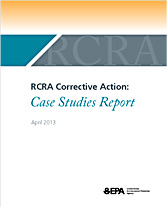Learn About RCRA Corrective Action
Congress amended the Resource Conservation and Recovery Act (RCRA) in November 1984, expanding the Act's cleanup provisions and prompting EPA and its state partners to develop the RCRA Corrective Action Program. The program now oversees the investigation and cleanup of nearly 4,000 hazardous waste sites across the country, including many with risks comparable to Superfund sites.
- RCRA Corrective Action sites in all 50 states and four U.S. territories cover 18 million acres of land.
- EPA estimates that more than 35 million people, roughly 12 percent of the U.S. population, live within one mile of a RCRA Corrective Action site (based on the 2000 U.S. Census).
RCRA Corrective Action facilities include many current and former chemical manufacturing plants, oil refineries, lead smelters, wood preservers, steel mills, commercial landfills, and a variety of other types of entities. Due to poor practices prior to environmental regulations, Corrective Action facilities have left large stretches of river sediments laden with PCBs; deposited lead in residential yards and parks beyond site boundaries; polluted drinking water wells in rural areas with chlorinated solvents; tainted municipal water supplies used by millions; and introduced mercury into waterways, necessitating fish advisories. At these sites, the Corrective Action Program ensures that cleanups occur. EPA and state regulators work with facilities and communities to design remedies based on the contamination, geology, and anticipated use unique to each site.
RCRA Corrective Action: Case Studies Report (April 2013)This report begins with an overview of the RCRA Corrective Action Program, including a discussion of the public health and environmental benefits of hazardous waste cleanups. The relationship between RCRA Corrective Action and other EPA cleanup programs is also explained. Information on the number, location, size, and cleanup progress of corrective action facilities is followed by case studies that profile a series of ongoing cleanups. Together, their stories illustrate the inherent challenges and real benefits of RCRA Corrective Action. EPA believes this information will help government officials and the general public make better and more cost-effective policy and business decisions.Case studies include:
|
 Download (PDF, 32 pp, 1 MB) | |
Download RCRA Corrective Action: Case Studies Report (PDF) (32 pp, 1 MB)
![[logo] US EPA](../gif/logo_epaseal.gif)